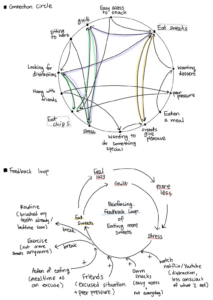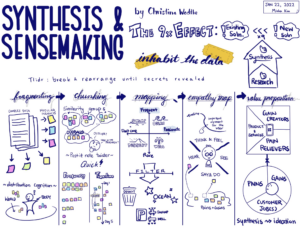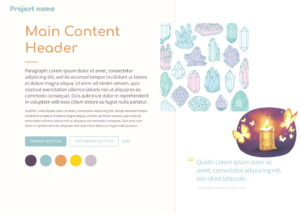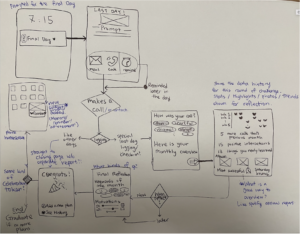Behaviour change? Design? That combination is exactly what I’m the worst at! I thought of all the times I planned to change some habit and then fail embarrassingly, as I wrote my application for this class. Exercising regularly, reducing screen time, walking more, procrastinating less, going to office hours, and too many more ideal behaviours that I was struggling to realise in reality – it was finally time to learn the secrets and fix my weak-willed self.
In class, we did start with identifying personal patterns and causal relationships through Measuring Me, though we quickly started looking outwardly too, learning about our study participants, developing personas, and the users of our project. I felt unqualified to be discussing ‘nudges’ and designing to help others change their behaviours when I hadn’t figured it out for myself.


My doubts aside, getting to hear a lot about design stories and examples in the industry, in previous and other classes, and from classmates’ experiences was my favourite part throughout the quarter, as I loved learning how the design tools and principles we discuss in classes are applied in real life. In contrast, I hated whenever I felt like things were out of my control, through which I was able to still learn so much. During quick iterations of idea generation, I had to learn how to be okay with leaving the dump of thoughts and moving onto the next step, trusting the process. With study findings and results, it was sometimes frustrating to not see the insights immediately, but given the process of fragmenting, reorganising and adding other people’s perspectives, we were able to eventually gain ideas that are more exciting and complex.
Sometimes, not having the time to fully understand what I was asked to do led to a waste of time and inefficiency, so it was important for me to listen and think through the task enough and understand the core questions first. Also, I wish I could have spent more time and space doing our group work, especially tuning into the physical or multisensory ways to brainstorm or generate thoughts, using the environment and tools in creative ways. We started doing this with post-it notes and mapping, as well as creating moodboards or learning clever sketch techniques, and I hope in the future there can be more space to explore such fun experiments that can help push our limits and help us tap into areas of our brain or experience that conventional discussion methods can’t.

I gained a huge set of vocabulary in this class and practical tools that help me generate, organise and present my thoughts. I will definitely use the systems thinking and casualty maps: connection circle, stock & flow, feedback loops in many other areas. I also love the wireflows, where I can take the advantage of quick layout designs of wireframes and the flows/transition understanding of the task flows. While building our prototype using all these tools, however, I was surprised by how complex existing apps actually are, despite their clean and simple aesthetics. So many functionalities have to be implemented with various conflicting values like accessibility, clarity, effectiveness and profitability taken into consideration. I now appreciate good design so much more, after learning about various design methods and principles that requires practice.

Ethics discussions gave me the most fascination and headache at the same time. For example, with the ‘nudging and manipulation’ discussion, as ‘Prompt’ is such a fundamental part of behaviour change – like in the commonly used B=MAP model – our project inevitable had to deal with ‘nudging’ people and influencing their behaviour choice. I was a little hesitant to use guilt as one of the motivation factors in our app, by showing a sad status when the user has not been keeping up with their challenge. We wanted to be extra careful that our product does not abuse the extrinsic motivation and instead rely on the intrinsic reward of better familial connections and gains from healthy and deeper relationships. As an attempt to realise that intrinsic motivation onto the screen of our app, we chose to use the flower pots as it’s a natural and intuitive parallel yet with positive and caring connotations of plants. This I believe can be a visual release or reflection of the guilty feelings and help the users make better decisions for themselves, rather than manipulating the users to behave a certain way that we as designers want.
Additionally, though we did entertain the thought of making user activity more sharable by including a ‘social’ aspect for inspiration and accountability, we did not move forward with this idea not only because of the intrinsic vs extrinsic motivation problem but also because of privacy issues. Anything to do with family can be more personal and sensitive compared to other types of relationships, and I imagine our app to be a small, cozy garden or warm private sanctuary where the users can dwell on it to recover and be energised from the solid foundation of their family instead of an open platform to share data and personal information. The feedback we got from the teaching team on linking the contact list to the app was also very insightful, where it reminded me of how we should be very intentional with what kinds of data we’re asking the users to give us and not to collect anything that we won’t end up using. I learned that lists of contact information are especially sensitive data and we have to be cautious of possible misuse of it as well as how much friction it creates for the users to use the product that asks for such information.
Another important topic of discussion within the team was having a very specific user group. Since this limits the user pool greatly and may exclude non-target users who still want to use the app, we based our specificity not to be on individual identity, but on motivation and relational situations. This way the product doesn’t reinforce the existing power imbalance in society while being able to be specific and effective for the target users. Frankly, not being able to tackle ‘difficult family relationships’ in our user group felt like a missed opportunity, as there are so many ways and degrees various families are imperfect. To leave the judgement –to use or not use the app– to the users does not prevent the dangers we want to avoid such as feeding into an existing negative family relationship or abusive relationships. This also resulted in excluding people with broken relationships from our design inside the app, when in reality they may be the ones who want to work on their family relationships the most. Having a healthy family, in various shapes and definitions, is very closely related to individual well-being and health. Throughout the project, we had to go back and make sure that our product doesn’t infringe on any delicate boundaries and sensitive topics around families by making false assumptions or not being aware of value misalignment.
Now, going back to the discrepancy I felt between my personal efforts in behaviour change and looking outwards to other people’s experiences and designing for them, I actually benefited so much from having to break my preconceived knowledge or assumptions about people and bahaviour, which was heavily based on my own experience and logic. By creating and discussing personas, as well as interviews and studies with participants, I gained so much insight into how different people have different values and definitions around what their ideals are, where their goals and problems lie, and what stops them from successfully changing their behaviours. There are definitely some commonalities among all of us struggling to work towards behaviour change, but many more differences and a broader spectrum of where we come from and where we are headed to. For me, this was another great experience that once again taught me that my perspectives are extremely limited and can only be based on my own thoughts if I am not intentionally putting effort into breaking out of that. To understand others and be inviting for positive changes, I need to do thorough research and study others’ stories in-depth, so that I not only create better designs for them but also in turn direct that learnings back inwardly and apply to parts of my own life that I could not connect before.
Behaviour change! … And, design! In my mind, those go hand in hand now as behaviour change, as challenging it still seems, can happen with good design, and design is for people to use or coexist in a certain way which influences our behaviours in a certain way. Moving forward, next time faced with challenges I feel unqualified for, I will again take a humble stance but not be discouraged by my lack of knowledge or expertise but be excited for how much I can learn and grow because of it. When given something that looks complex and unsolvable, I now have so many tools I can borrow from this class and break down various aspects into more digestible pieces. Even if it still remains to be complicated and difficult to change, like behaviour change, I feel more equipped to map various systems within the problem using various models, trust the process, see through my assumptions and work to break or confirm them with handy experiments, and work with others who will bring insights and perspectives to expand the scope and dimensions we work with to tackle the problem.



